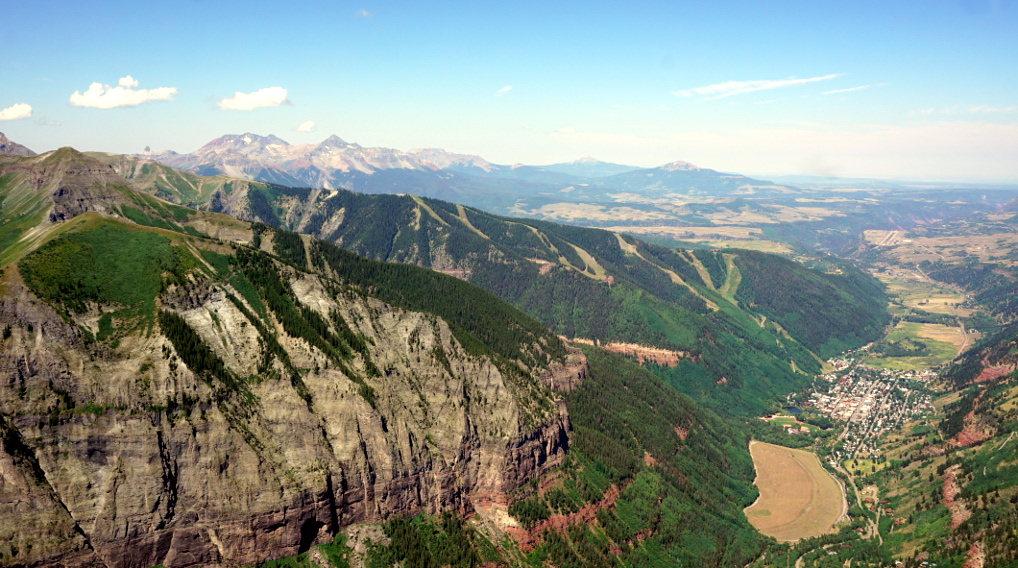
The town of Telluride observed from Ajax Peak © Ivana Kajić
This year I had the pleasure of participating at the 25th Telluride Neuromorphic Cognition Engineering Workshop. When I tell people this is how I spent my summer, I can not help but notice looks prompting questions such as “You did what?… and where?”. This post will summarize what was happening during the three weeks of the workshop that took place in July this year. Scientists and researchers from all over the world, also known as neuromorphs, gathered once again to study the brain using a variety of approaches, to build robots and work with unconventional hardware. They predicted what people listened to from brain signals, tracked sattelites and made AI systems that play foosball. And all of that was happening in the small town of Telluride.
Telluride is a mountainous town with a rich history, located at an altitude of 2,670 m (8,750 feet) in the heart of Colorado, USA. As happens to be the case with many such towns in that part of the world, its history is rooted in heavy mining activity that started some time in 19th century. Today, rather than miners, the mountains of Telluride attract a variety of adventure seekers and nature lovers including skiers, hikers, runners, mountain bikers and climbers, to name a few. Also, there are the neuromorphs.
Neuromorphs are the adventure seekers of a different kind. Rather than looking for gold, or adrenaline, they look for answers to really hard questions about how the brain works. It is a community of scientists from different backgrounds that gathers annually in this tiny town not only to look for answers and build robots, but also to disseminate the knowledge and impart the enthusiasm to newer generations of scientists.
This year, the workshop was held in the local elementary school, a beautiful building with picturesque views of the surrounding mountains. I did not anticipate that waking up in the morning and strolling to the school to attend the morning sessions would be such a pleasant activity. During first two weeks, the morning schedule was mostly filled with different talks and tutorials. Presentations covered a variety of areas such as neuroscience, robotics, machine learning and emerging technologies; introduced various hardware such as different neuromorphic chips, event-based cameras and all kinds of robots; and software for simulation of neural networks, both for cognitive modelling and machine learning. During the first week, we also formed groups to work on projects with other participants.
One “house specialty” of the workshop is the focus on neuromorphic hardware: low-energy hardware specifically designed to support efficient computations in neural networks. As deep neural networks gain more importance in computer vision and other domains, optimized hardware requiring less power than conventional counterparts such as CPUs and GPUs is becoming increasingly relevant. At this workshop, participants had an opportunity to work with two such new chips: Intel’s Loihi, and Braindrop, a chip designed by researchers from Stanford University.
The last week of the workshop was centered around the projects. I was part of a group that explored algorithms and approaches for agents that are able to learn and function in real-world environments. While humans can quite easily adapt to small changes in the environment, noise and even smallest perturbations in the input signals can be problematic for machines and AI systems. Within my team, we built a minimalistic system that is able to recognize a few different kinds of objects in real-time. The system contains an AIY vision kit and an AIY voice kit. The vision kit contains a small camera attached to a Raspberry Pi, which in turn communicates with a Movidius chip. The chip is equipped with neural networks precompiled for a variety of tasks, including feature extraction, which we used to collect the data on different objects. Then, we used those features to train a neural network in Keras that we ported onto the Raspberry Pi. The model was running in real time and it was able to recognize novel, previously unseen examples of familiar kinds of objects. A short video of this system in action is available here. Since I found myself opening and closing the cardboard case that contained vision kit components more often than I expected, I decided to make my own case out of Legos which turned out to be a more robust (and colourful) solution.
Although the workshop was quite intense and long, I enjoyed every single day. There were plenty of opportunities for interactions with other participants, organizers and invited speakers. I learned as much during the talks and tutorials as I did during random chats and conversations we had over BBQs, poker evenings and hikes. Aside from being great scientists and researchers, individuals I interacted with were also great people with wonderful personalities. I consider myself lucky to have had a chance to get inspired by their stories and experiences.
Such a remote location* and the small size of the town facilitated a collegial, collaborative atmosphere as it was easy to do things spontaneously (such as re-arranging the talks so people could watch World Cup matches… to joys of some and sorrows of others!). I particularly liked how the free time was incorporated into the official schedule every evening – there was ample time to enjoy outdoors, rest and have dinner. I learned a lot while having a great time, and I would encourage anyone working in this domain to apply for the workshop.
I will follow-up with another, separate post on what I did in Colorado after the workshop. The post will be about the road trip I did with a good friend of mine, and our adventures in the unspoiled, captivating wilderness of Colorado.
* The photo was taken by Aaron Voelker.